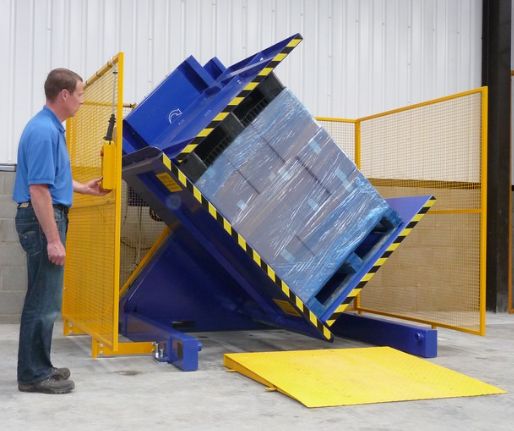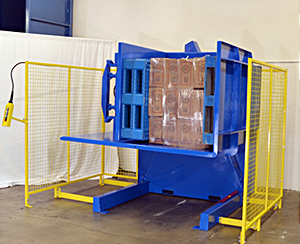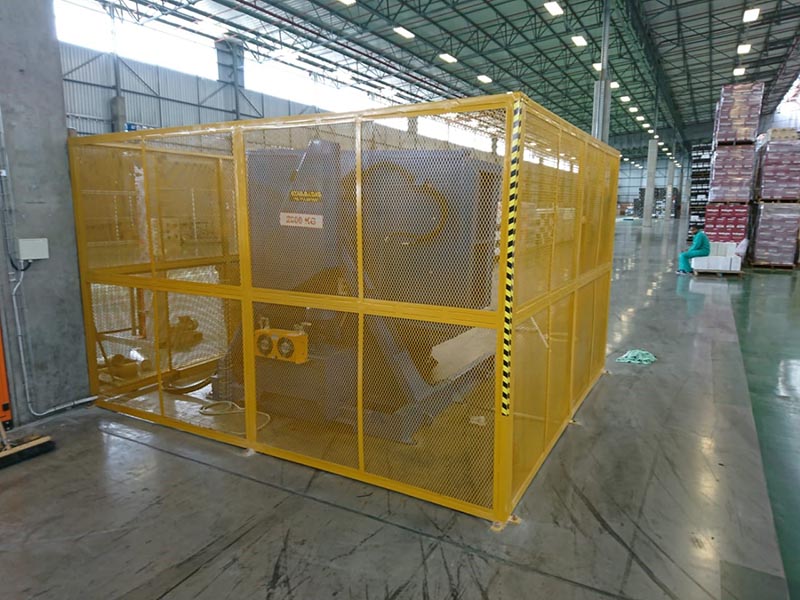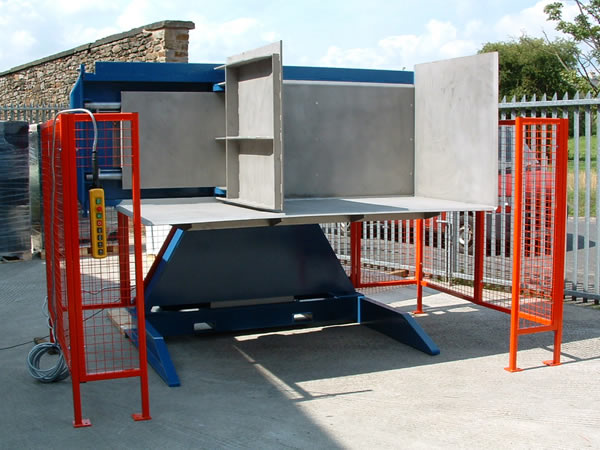What’s the ROI of Automated Pallet Changing Machines in Indonesia's Industrial Sector?
Are you watching your operational costs climb in Indonesia? You see the rising wages, the cost of accidents, and the bottlenecks that slow down your entire production line. It feels like you're constantly fighting to protect your margins. This slow, manual process of changing pallets is a hidden drain on your business. It's not just inefficient; it's risky for your workers and your products. But what if you could solve these problems with a single, strategic investment? An automated pallet changing machine is more than just new equipment; it's a direct solution to cut costs, improve safety, and boost your factory's output.
The return on investment (ROI) for an automated pallet changing machine in Indonesia's industrial sector is typically realized within 12 to 24 months. This ROI is driven by significant reductions in direct labor costs, a dramatic increase in operational speed and throughput, minimized product damage, and enhanced worker safety, which lowers insurance and compensation expenses. For a typical Indonesian manufacturing or logistics facility, the quantifiable savings in wages, efficiency gains, and protected goods quickly surpass the initial capital outlay.

This might sound like a simple calculation, but the real value is in the details. I’ve spent my entire career in this industry, first as an engineer on the factory floor and now as the owner of my own packing machine factory. I’ve seen firsthand how a single piece of automation can transform an entire operation. The benefits go far beyond what you can see on a simple spreadsheet. Let's dig deeper into where these savings really come from and how you can apply them to your business in Indonesia.
How Do Automated Pallet Changers Directly Reduce Labor Costs in Indonesia?
You look at your payroll every month, and the numbers are always going up. The Upah Minimum Regional (UMR) in Indonesia continues to rise, and finding skilled, reliable workers for physically demanding jobs is a constant challenge. You're not just paying salaries; you're paying for overtime, benefits, and the high cost of turnover. This constant cycle of hiring and training for manual handling jobs feels like a leak in your company's budget. An automated pallet changer plugs that leak. It’s a solution that works 24/7 without needing breaks or benefits, directly targeting one of your biggest and most unpredictable expenses.
Automated pallet changers directly reduce labor costs by replacing the need for multiple workers per shift to manually transfer goods. A single machine can do the work of two to four people, eliminating their wages, overtime pay, and associated benefit costs. This also cuts down on the recurring expenses of recruiting, hiring, and training new staff for physically demanding, high-turnover positions in your Indonesian facility.

A Detailed Look at Labor Savings
When I work with factory owners, I encourage them to look beyond just the hourly wage. The true cost of a manual process is much higher. Let's break it down. Think about a typical manual pallet transfer. You might need two workers and a forklift driver. That’s three people involved in one simple task. If your factory runs two or three shifts, this number multiplies quickly. The machine, on the other hand, needs only one supervisor for multiple lines.
Let's compare the costs in a more structured way. This is the kind of analysis I do for my clients, and it's something I learned to do for my own factory.
| Cost Factor | Manual Handling (Per Year, Per Shift) | Automated Handling (Per Year) | Notes |
|---|---|---|---|
| Direct Wages | 2-3 Workers x 12 Months x UMR | Minimal supervision cost | UMR varies by region (e.g., Jakarta, Cikarang), but the principle is the same. |
| Overtime Pay | High due to production peaks & delays | Almost zero | Machines don't get tired and can run continuously during peak demand. |
| Benefits (BPJS) | Required for each employee | Required for fewer employees | A significant and legally required cost in Indonesia. |
| Recruitment & Training | High due to high turnover rate | One-time training for operators | Manual labor has a high turnover rate, creating a constant hiring need. |
| Management Overhead | More supervisors needed | Fewer supervisors needed | Less time spent managing schedules, absences, and performance issues. |
I remember a client in the Tangerang industrial area. They produced consumer goods and were constantly struggling with labor. Their palletizing area was chaotic. Every time a big order came in, they had to pay huge amounts of overtime. Workers got tired, and mistakes happened. After we installed a pallet inverter, they reassigned four workers per shift to more valuable roles. The cost savings from wages and overtime alone paid for the machine in just over 18 months. But more importantly, the manager could finally focus on production planning instead of constantly trying to fill gaps in the work schedule. That’s a real, tangible change.
What Are the Hidden Operational Gains from Pallet Changing Automation?
So you’ve addressed the obvious labor costs. But your factory floor still feels like there are invisible speed bumps everywhere. A production line stops because it's waiting for a forklift. A truck sits at the loading dock because the pallets aren't ready. These small delays and inefficiencies are hard to measure, but you can feel them. They disrupt your production rhythm, extend your lead times, and eat away at your plant's total capacity. Automation is the answer. It creates a smooth, predictable flow. It removes those hidden speed bumps and unlocks a level of productivity you didn't realize was possible.
The hidden operational gains from pallet changing automation are immense. They include a significant increase in throughput because machine cycle times are seconds, not minutes. This leads to less equipment downtime across your entire line, better use of your expensive factory floor space, and more accurate inventory control. These benefits combine to boost overall productivity far beyond simple labor savings, directly impacting your bottom line.

Unlocking Speed and Throughput
Let’s talk about time. In manufacturing, time is everything. A manual pallet change, from getting the forklift to re-stacking the goods, can take anywhere from 5 to 15 minutes. It depends on the skill of the workers and the type of product. An automated pallet changer does the same job in under 60 seconds. Every single time.
Let's do some simple math. Assume a conservative manual time of 8 minutes and a machine time of 1 minute. That's a saving of 7 minutes per pallet. If your line handles 10 pallets per hour, you save 70 minutes of production time every single hour. Over a full 24-hour day, that adds up to 28 hours of saved time. You have essentially created more than a full extra shift of production capacity without adding a single person or extending your workday. This is what we mean by hidden gains. You are not just doing the same work faster; you are creating the ability to do more work.
Optimizing Your Factory Footprint
Factory space in Indonesian industrial estates like MM2100 or Jababeka is not cheap. Every square meter needs to be productive. Manual pallet changing requires a lot of open space. You need room for forklifts to maneuver, staging areas for incoming and outgoing pallets, and space for workers to operate safely. It's often a messy and inefficient use of valuable floor space.
An automated pallet changer is a compact, self-contained unit. It can be integrated directly into your conveyor system. This eliminates the need for large, open staging areas. I have seen clients reclaim hundreds of square meters of floor space after installing one of our machines. They used that new space to add another packaging line or to create more warehouse storage. By making your process more compact, you make your entire factory more valuable and productive. It’s like finding new land without having to buy it.
How Does Automation Impact Worker Safety and Product Quality?
A serious workplace accident is a factory owner's worst nightmare. It can stop production, lead to heavy fines, and damage your company's reputation. At the same time, a single pallet of damaged goods rejected by a customer can wipe out the profit from an entire shipment. Both of these risks are incredibly high with manual handling. Back injuries from heavy lifting are common, and a tired worker is far more likely to drop or mishandle a pallet. Automation removes your people from these dangerous and repetitive tasks. It creates a safer work environment and handles your products with a consistency that humans simply cannot match, protecting both your people and your profits.
Automation provides a dual benefit: it drastically improves worker safety and enhances product quality. By taking over the physically strenuous task of lifting and re-stacking, it nearly eliminates the risk of back strains and other musculoskeletal injuries. For products, the machine's gentle and controlled handling minimizes the chance of damage from being dropped, crushed, or improperly stacked, ensuring your goods arrive at the customer in perfect condition.

Building a Safer Workplace
In my early days as an engineer, I saw too many injuries related to manual handling. Back strains, crushed fingers, foot injuries—these were common. These incidents are not just personal tragedies for the workers; they are major disruptions for the business. An injured worker means lost time, medical costs, and potential legal issues. In Indonesia, complying with government safety standards (SMK3 - Sistem Manajemen Keselamatan dan Kesehatan Kerja) is not optional.
An automated pallet changer is one of the most effective safety controls you can implement. The machine does all the heavy lifting. It takes the worker out of the danger zone. The only human interaction is pushing a button. The result is a dramatic drop in lifting-related injuries. This leads to fewer lost workdays, lower costs for worker compensation insurance, and a better, safer environment that helps you retain good employees. They can be re-skilled for safer, more valuable jobs like quality control or machine supervision. This is not about replacing workers; it is about protecting them and elevating their roles.
Protecting Your Products, Protecting Your Brand
Think about the last time you saw a damaged pallet. Maybe it was a stack of boxes that had shifted and crushed the ones at the bottom. Or maybe a forklift driver took a corner too fast. This is the reality of manual handling. Humans get tired, they get distracted, and mistakes happen.
A machine does not get tired. Its movements are programmed and perfectly repeatable. Whether it’s the first pallet of the day or the last, the handling is identical. This is critical for many industries in Indonesia. For food and beverage companies, it ensures hygienic handling. For electronics manufacturers, it prevents shock and damage to sensitive components. For chemical or cement companies, it safely handles heavy, unstable loads. Consistent, gentle handling means fewer rejected shipments, happier customers, and a stronger brand reputation. The cost of one lost container of goods due to damage can often be a significant fraction of the cost of the machine that would have prevented it.
What's My Take on This as an Engineer and Factory Owner?
You've seen the numbers on paper, and the ROI looks promising. But I know the question that keeps a factory owner like you up at night: "This sounds good, but will it actually work in my factory, with my products and my people?" You worry about buying a machine that doesn't fit, or worse, a supplier who sells you a box and then disappears. I've seen it happen, and it’s a costly mistake. It turns a potential solution into an expensive paperweight on your factory floor. As someone who has designed these machines and now relies on them in my own factory, I can tell you the secret. The success of your investment is not just in the machine itself. It’s in the partner you choose.
My honest take is this: the real ROI of an automated pallet changer comes from finding a true partner, not just a supplier. The machine's specifications are only half the story. You need a partner who understands your specific operational challenges in Indonesia, helps customize the right solution, and provides reliable local support long after the installation. A total solution is what guarantees your investment will deliver value for years to come.

This Is Not a One-Size-Fits-All Solution
When I first started my own factory, I was focused on saving every penny. I almost bought a standard, off-the-shelf machine because it was cheaper. But then my engineering background kicked in. I stopped and thought about my specific needs. My pallets were slightly different. My product loads were unstable. The standard machine would have failed. That experience taught me a crucial lesson: customization is not a luxury; it is a necessity.
Every factory in Indonesia is different. You might be using locally made wooden pallets that aren't a standard size. You might be handling heavy steel coils, fragile food products, or large bags of agricultural goods. A good partner will ask these questions. They will conduct a proper site audit. They will analyze your:
- Pallet Types: Wood, plastic, standard EURO, or custom local sizes?
- Load Characteristics: Is it heavy, light, stable, unstable, fragile?
- Factory Layout: How will the machine fit into your existing production flow?
- Integration Needs: Does it need to connect with your conveyors, wrappers, or MES?
Choosing the cheapest machine is often the most expensive mistake. The right machine is the one that is engineered for your reality.
The Power of a True Partnership
This brings me to my final and most important point. When you are making a capital investment like this, you are not just buying steel and motors. You are buying a promise. A promise of performance, reliability, and support. A true strategic partner, like the kind of company I strive for SHJLPACK to be, delivers on that promise.
What does that look like?
- They help you build the business case. They work with you to accurately calculate the ROI for your specific situation.
- They manage the project. Installation, commissioning, and integration are handled professionally.
- They provide local training. Your team in Indonesia needs to be trained in their own language by people who understand the local culture.
- They offer local support. When you need a spare part or technical help, you need someone who can respond quickly, not someone in a different time zone.
This is why I built SHJLPACK with a mission to be a knowledge-sharing platform. My goal is to give you the insights I’ve gained over 25 years so you can make the best possible decision. Your success is my success.
Conclusion
Automating pallet changing in Indonesia is more than a cost-saving tactic. It's a strategic investment in efficiency, worker safety, and future growth. The right machine from the right partner pays for itself.




